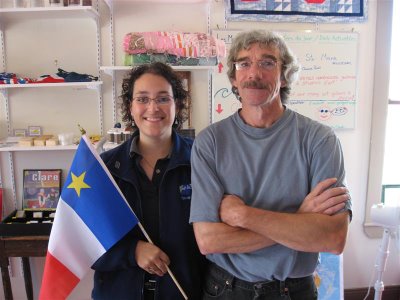Vive l'Acadie!
and her colleague Denis (with an equally long name)
Day 9: Digby ~ Lunenburg (396km)
It took us about 4 hours to cover our first 60 kilometres this morning, but it was such a great experience that neither of us were complaining. Thinking we had plenty of time to cover the day's kilometres to Halifax, we started out later than usual under sunny skies and warm temperatures and stuffed on the great breakfast our B&B had prepared. We opted for the scenic and winding Route 1 as opposed to the more inland and speedy arterial highway 101 in the hopes of getting a nice coastal drive and seeing some of the smaller towns and villages along the way.
Our route was to take us through the heart of Acadian Nova Scotia. I admit that before this trip I knew of the Acadian settlements here but was little interested in the people or their history. However, driving through these picturesque little towns on the ocean and seeing the Acadian flag flapping from nearly every home, it starts to pull you in, and so it did this day. Along the way we visited two magnificent churches in two different villages. One, Eglise St. Bernard, was a majestic stone building built by a master builder who was illiterate but could still get by with architectural plans. The second church was St.Mary's, the largest wooden church in North America, and its clapboard facade glowed bright white in the sunshine against the deep blue sky. Strangely enough, despite the fact that it was a Catholic church, we had to pay $2 each just to get in the front doors, something I found quite unusual, since in all my travels in all the world I've never once had to pay for entry into a Catholic church.
Passing St. Bernard's we zipped by a tiny souvenir and information booth along the road, but for some reason it had caught my eye and I wanted to go back and take a look at the souvenirs and perhaps pick up a small reminder of all the flapping Acadian flags we had seen. Inside, we got talking with the manager of the tourism office as well as a colleague who looked to be starting some kind of new display. We ended up chatting for half an hour and learned so much about the interesting history and culture of the Acadians in Canada.
It would take me pages to try and regurgitate all the incredible knowledge that these two shared with us, but it was all so new and so fascinating (to me, at least), and it was clear that they were very proud of their heritage. They told us that in recent times things had changed and within the Acadian community it was now "cool to be Acadian". For those who need a brush up, Acadia was the French name for all of France's North American colonies during the first settlement period (Annapolis Royal was founded in 1605), and Acadia once covered eastern Quebec, New Brunswick, PEI and Nova Scotia. The history is long and involved, but the gist of it is that the Acadians were quite happy where they were and refused to take sides as the French and the British battled for hundreds of years over the colonies. This eventually led to many of them being expelled by the British in 1755 (the Great Expulsion), a dark spot in Acadian history.
These days, as I said, it's cool to be Acadian, and the Acadian language is very much alive and kicking. I had heard about Acadian French but never actually heard it, so I asked Nicole, the manager, and Denis, her colleague, to give me a little sample. I didn't understand a word of what they were saying! I have trouble on occasion with quebecois but can understand it for the most part, but this was simply incomprehensible! Nicole then proceded to give me a quick 3-point lesson on Acadian French, which I'll have to write down before I forget. It's quite similar to the provençal French of the 1700s, when a lot of Acadians came from France to settle there. In fact, visitors from France often tell her that she speaks like their great-great grandfather. She also explained that they don't much use last names to refer to each other or inquire about someone else, since there are a lot of people with similar names. Instead, they mention paternal lineage in the name, and might go back two or three generations with this until it includes someone relatively famous. Thus, she explained, if someone were asking to find her, they might ask where Nicole à Russell à Denis à Simide was. "That's a mouthful," I said.
A good chunk of time later we finally said our goodbyes and went on our way, full of Acadian heritage, but not before Nicole offered us two signed copies of her short book (that was otherwise selling for $10). We continued our drive down the coast looking out for a handful of sights she had recommended and stopping for lunch at St. Mary's Point at a restaurant over looking the ocean and a gorgeous beach. There we dug into Rappie Pie (or Rapure, in French), a uniquely Acadian dish made from meat and grated, de-juiced potatoes (don't ask me to explain), cooked with some spices and broth in the oven until golden brown. Admittedly, the whole thing doesn't look incredibly appealing on the plate, but it was quite good. In the booth behind us, two Acadian women were having lunch and chatting away using an incredible smorgasbord of Acadian, English and French (at times all in one sentence!) that would have left a sociolinguist drooling.
All this Acadian business had put us quite behind schedule and after lunch it was clear to us that we would not make Halifax by nightfall, especially if we were expecting to stop in Lunenburg and Peggy's Cove along the way. So we set a new goal of Lunenburg and find ourselves tonight in this UNESCO World Heritage town in an apartment right by the harbour where none other than the Bluenose II is docked at this very moment. We're going to do our best to be on the morning sailing, so it's off to bed right now!
Our route was to take us through the heart of Acadian Nova Scotia. I admit that before this trip I knew of the Acadian settlements here but was little interested in the people or their history. However, driving through these picturesque little towns on the ocean and seeing the Acadian flag flapping from nearly every home, it starts to pull you in, and so it did this day. Along the way we visited two magnificent churches in two different villages. One, Eglise St. Bernard, was a majestic stone building built by a master builder who was illiterate but could still get by with architectural plans. The second church was St.Mary's, the largest wooden church in North America, and its clapboard facade glowed bright white in the sunshine against the deep blue sky. Strangely enough, despite the fact that it was a Catholic church, we had to pay $2 each just to get in the front doors, something I found quite unusual, since in all my travels in all the world I've never once had to pay for entry into a Catholic church.
Passing St. Bernard's we zipped by a tiny souvenir and information booth along the road, but for some reason it had caught my eye and I wanted to go back and take a look at the souvenirs and perhaps pick up a small reminder of all the flapping Acadian flags we had seen. Inside, we got talking with the manager of the tourism office as well as a colleague who looked to be starting some kind of new display. We ended up chatting for half an hour and learned so much about the interesting history and culture of the Acadians in Canada.
It would take me pages to try and regurgitate all the incredible knowledge that these two shared with us, but it was all so new and so fascinating (to me, at least), and it was clear that they were very proud of their heritage. They told us that in recent times things had changed and within the Acadian community it was now "cool to be Acadian". For those who need a brush up, Acadia was the French name for all of France's North American colonies during the first settlement period (Annapolis Royal was founded in 1605), and Acadia once covered eastern Quebec, New Brunswick, PEI and Nova Scotia. The history is long and involved, but the gist of it is that the Acadians were quite happy where they were and refused to take sides as the French and the British battled for hundreds of years over the colonies. This eventually led to many of them being expelled by the British in 1755 (the Great Expulsion), a dark spot in Acadian history.
These days, as I said, it's cool to be Acadian, and the Acadian language is very much alive and kicking. I had heard about Acadian French but never actually heard it, so I asked Nicole, the manager, and Denis, her colleague, to give me a little sample. I didn't understand a word of what they were saying! I have trouble on occasion with quebecois but can understand it for the most part, but this was simply incomprehensible! Nicole then proceded to give me a quick 3-point lesson on Acadian French, which I'll have to write down before I forget. It's quite similar to the provençal French of the 1700s, when a lot of Acadians came from France to settle there. In fact, visitors from France often tell her that she speaks like their great-great grandfather. She also explained that they don't much use last names to refer to each other or inquire about someone else, since there are a lot of people with similar names. Instead, they mention paternal lineage in the name, and might go back two or three generations with this until it includes someone relatively famous. Thus, she explained, if someone were asking to find her, they might ask where Nicole à Russell à Denis à Simide was. "That's a mouthful," I said.
A good chunk of time later we finally said our goodbyes and went on our way, full of Acadian heritage, but not before Nicole offered us two signed copies of her short book (that was otherwise selling for $10). We continued our drive down the coast looking out for a handful of sights she had recommended and stopping for lunch at St. Mary's Point at a restaurant over looking the ocean and a gorgeous beach. There we dug into Rappie Pie (or Rapure, in French), a uniquely Acadian dish made from meat and grated, de-juiced potatoes (don't ask me to explain), cooked with some spices and broth in the oven until golden brown. Admittedly, the whole thing doesn't look incredibly appealing on the plate, but it was quite good. In the booth behind us, two Acadian women were having lunch and chatting away using an incredible smorgasbord of Acadian, English and French (at times all in one sentence!) that would have left a sociolinguist drooling.
All this Acadian business had put us quite behind schedule and after lunch it was clear to us that we would not make Halifax by nightfall, especially if we were expecting to stop in Lunenburg and Peggy's Cove along the way. So we set a new goal of Lunenburg and find ourselves tonight in this UNESCO World Heritage town in an apartment right by the harbour where none other than the Bluenose II is docked at this very moment. We're going to do our best to be on the morning sailing, so it's off to bed right now!



0 Comments:
Post a Comment
<< Home